Challenges for Australian Law Enforcement in Investigating and Prosecuting Cybercrime
VerifiedAdded on 2023/06/03
|12
|4695
|320
AI Summary
This study critically examines the significant challenges that face the enforcement of the law against cybercrimes in Australia in the investigation and prosecution of cybercriminals drawing on numerous available examples.
Contribute Materials
Your contribution can guide someone’s learning journey. Share your
documents today.

CYBERCRIME 1
Q3. What are most significant challenges for Australian law enforcement investigating and
prosecuting cybercrime? Support your argument with multiple examples.
By; Student’s Name
Name of the Class and Course
Professor
Name of University
City and State
Date
Q3. What are most significant challenges for Australian law enforcement investigating and
prosecuting cybercrime? Support your argument with multiple examples.
By; Student’s Name
Name of the Class and Course
Professor
Name of University
City and State
Date
Secure Best Marks with AI Grader
Need help grading? Try our AI Grader for instant feedback on your assignments.
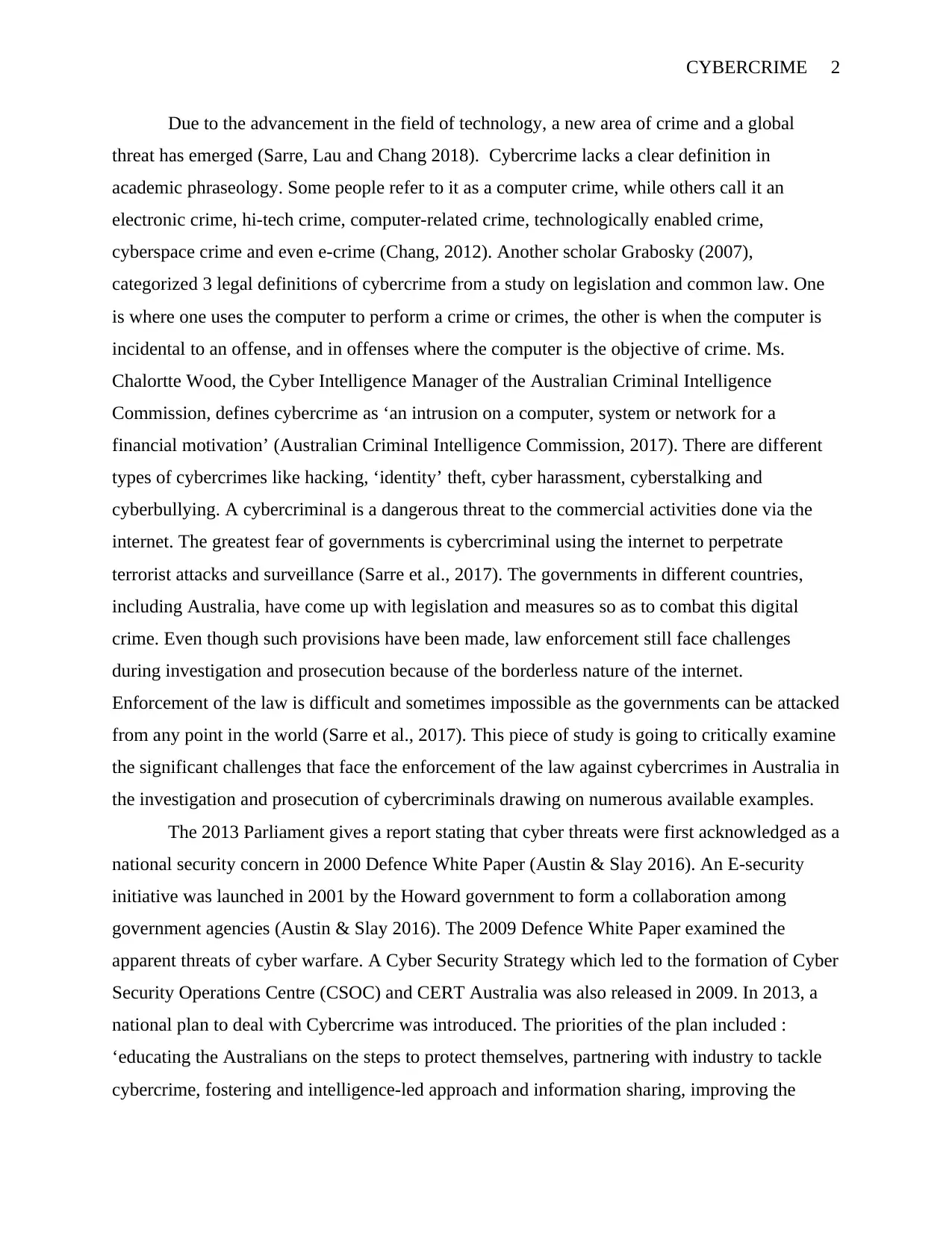
CYBERCRIME 2
Due to the advancement in the field of technology, a new area of crime and a global
threat has emerged (Sarre, Lau and Chang 2018). Cybercrime lacks a clear definition in
academic phraseology. Some people refer to it as a computer crime, while others call it an
electronic crime, hi-tech crime, computer-related crime, technologically enabled crime,
cyberspace crime and even e-crime (Chang, 2012). Another scholar Grabosky (2007),
categorized 3 legal definitions of cybercrime from a study on legislation and common law. One
is where one uses the computer to perform a crime or crimes, the other is when the computer is
incidental to an offense, and in offenses where the computer is the objective of crime. Ms.
Chalortte Wood, the Cyber Intelligence Manager of the Australian Criminal Intelligence
Commission, defines cybercrime as ‘an intrusion on a computer, system or network for a
financial motivation’ (Australian Criminal Intelligence Commission, 2017). There are different
types of cybercrimes like hacking, ‘identity’ theft, cyber harassment, cyberstalking and
cyberbullying. A cybercriminal is a dangerous threat to the commercial activities done via the
internet. The greatest fear of governments is cybercriminal using the internet to perpetrate
terrorist attacks and surveillance (Sarre et al., 2017). The governments in different countries,
including Australia, have come up with legislation and measures so as to combat this digital
crime. Even though such provisions have been made, law enforcement still face challenges
during investigation and prosecution because of the borderless nature of the internet.
Enforcement of the law is difficult and sometimes impossible as the governments can be attacked
from any point in the world (Sarre et al., 2017). This piece of study is going to critically examine
the significant challenges that face the enforcement of the law against cybercrimes in Australia in
the investigation and prosecution of cybercriminals drawing on numerous available examples.
The 2013 Parliament gives a report stating that cyber threats were first acknowledged as a
national security concern in 2000 Defence White Paper (Austin & Slay 2016). An E-security
initiative was launched in 2001 by the Howard government to form a collaboration among
government agencies (Austin & Slay 2016). The 2009 Defence White Paper examined the
apparent threats of cyber warfare. A Cyber Security Strategy which led to the formation of Cyber
Security Operations Centre (CSOC) and CERT Australia was also released in 2009. In 2013, a
national plan to deal with Cybercrime was introduced. The priorities of the plan included :
‘educating the Australians on the steps to protect themselves, partnering with industry to tackle
cybercrime, fostering and intelligence-led approach and information sharing, improving the
Due to the advancement in the field of technology, a new area of crime and a global
threat has emerged (Sarre, Lau and Chang 2018). Cybercrime lacks a clear definition in
academic phraseology. Some people refer to it as a computer crime, while others call it an
electronic crime, hi-tech crime, computer-related crime, technologically enabled crime,
cyberspace crime and even e-crime (Chang, 2012). Another scholar Grabosky (2007),
categorized 3 legal definitions of cybercrime from a study on legislation and common law. One
is where one uses the computer to perform a crime or crimes, the other is when the computer is
incidental to an offense, and in offenses where the computer is the objective of crime. Ms.
Chalortte Wood, the Cyber Intelligence Manager of the Australian Criminal Intelligence
Commission, defines cybercrime as ‘an intrusion on a computer, system or network for a
financial motivation’ (Australian Criminal Intelligence Commission, 2017). There are different
types of cybercrimes like hacking, ‘identity’ theft, cyber harassment, cyberstalking and
cyberbullying. A cybercriminal is a dangerous threat to the commercial activities done via the
internet. The greatest fear of governments is cybercriminal using the internet to perpetrate
terrorist attacks and surveillance (Sarre et al., 2017). The governments in different countries,
including Australia, have come up with legislation and measures so as to combat this digital
crime. Even though such provisions have been made, law enforcement still face challenges
during investigation and prosecution because of the borderless nature of the internet.
Enforcement of the law is difficult and sometimes impossible as the governments can be attacked
from any point in the world (Sarre et al., 2017). This piece of study is going to critically examine
the significant challenges that face the enforcement of the law against cybercrimes in Australia in
the investigation and prosecution of cybercriminals drawing on numerous available examples.
The 2013 Parliament gives a report stating that cyber threats were first acknowledged as a
national security concern in 2000 Defence White Paper (Austin & Slay 2016). An E-security
initiative was launched in 2001 by the Howard government to form a collaboration among
government agencies (Austin & Slay 2016). The 2009 Defence White Paper examined the
apparent threats of cyber warfare. A Cyber Security Strategy which led to the formation of Cyber
Security Operations Centre (CSOC) and CERT Australia was also released in 2009. In 2013, a
national plan to deal with Cybercrime was introduced. The priorities of the plan included :
‘educating the Australians on the steps to protect themselves, partnering with industry to tackle
cybercrime, fostering and intelligence-led approach and information sharing, improving the
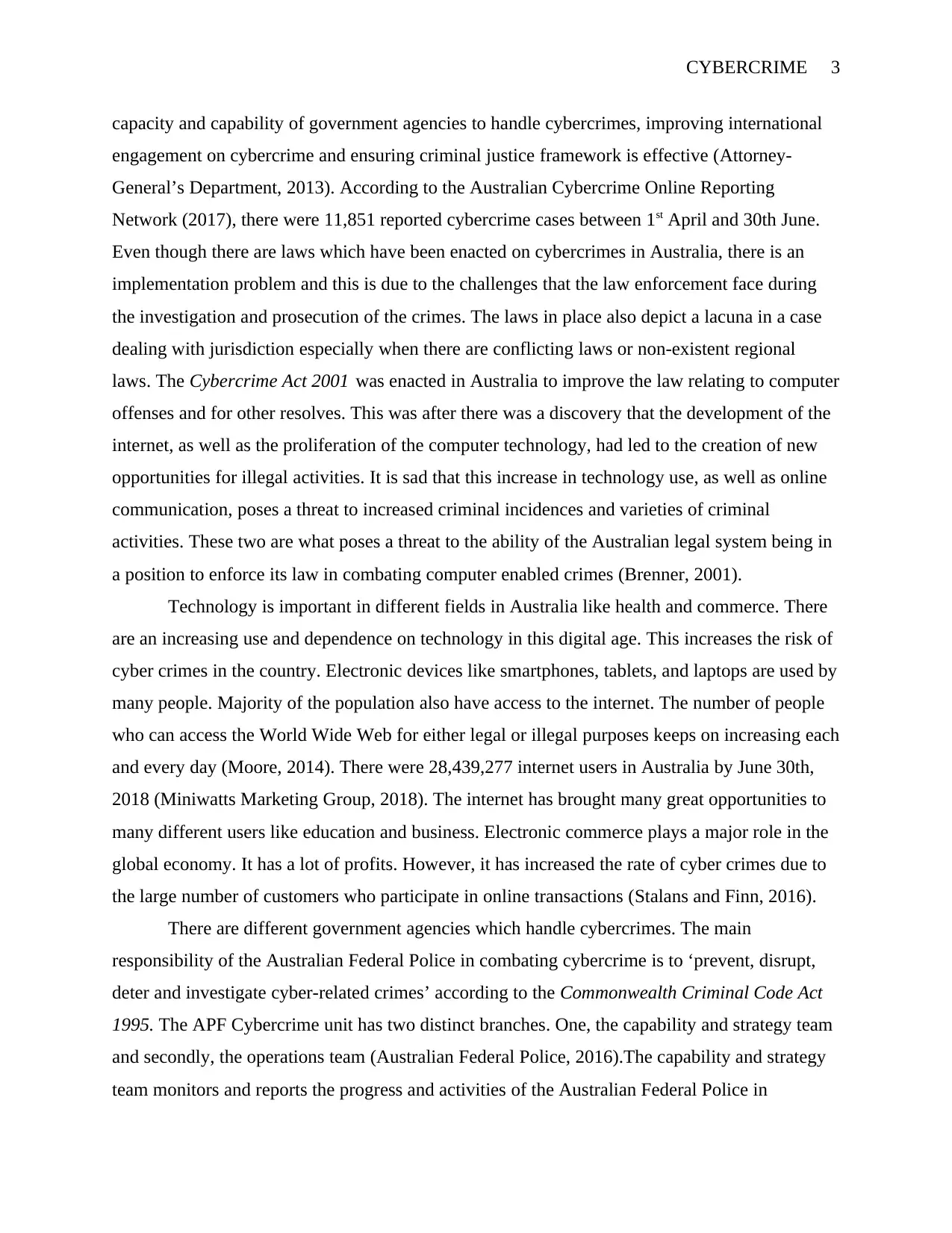
CYBERCRIME 3
capacity and capability of government agencies to handle cybercrimes, improving international
engagement on cybercrime and ensuring criminal justice framework is effective (Attorney-
General’s Department, 2013). According to the Australian Cybercrime Online Reporting
Network (2017), there were 11,851 reported cybercrime cases between 1st April and 30th June.
Even though there are laws which have been enacted on cybercrimes in Australia, there is an
implementation problem and this is due to the challenges that the law enforcement face during
the investigation and prosecution of the crimes. The laws in place also depict a lacuna in a case
dealing with jurisdiction especially when there are conflicting laws or non-existent regional
laws. The Cybercrime Act 2001 was enacted in Australia to improve the law relating to computer
offenses and for other resolves. This was after there was a discovery that the development of the
internet, as well as the proliferation of the computer technology, had led to the creation of new
opportunities for illegal activities. It is sad that this increase in technology use, as well as online
communication, poses a threat to increased criminal incidences and varieties of criminal
activities. These two are what poses a threat to the ability of the Australian legal system being in
a position to enforce its law in combating computer enabled crimes (Brenner, 2001).
Technology is important in different fields in Australia like health and commerce. There
are an increasing use and dependence on technology in this digital age. This increases the risk of
cyber crimes in the country. Electronic devices like smartphones, tablets, and laptops are used by
many people. Majority of the population also have access to the internet. The number of people
who can access the World Wide Web for either legal or illegal purposes keeps on increasing each
and every day (Moore, 2014). There were 28,439,277 internet users in Australia by June 30th,
2018 (Miniwatts Marketing Group, 2018). The internet has brought many great opportunities to
many different users like education and business. Electronic commerce plays a major role in the
global economy. It has a lot of profits. However, it has increased the rate of cyber crimes due to
the large number of customers who participate in online transactions (Stalans and Finn, 2016).
There are different government agencies which handle cybercrimes. The main
responsibility of the Australian Federal Police in combating cybercrime is to ‘prevent, disrupt,
deter and investigate cyber-related crimes’ according to the Commonwealth Criminal Code Act
1995. The APF Cybercrime unit has two distinct branches. One, the capability and strategy team
and secondly, the operations team (Australian Federal Police, 2016).The capability and strategy
team monitors and reports the progress and activities of the Australian Federal Police in
capacity and capability of government agencies to handle cybercrimes, improving international
engagement on cybercrime and ensuring criminal justice framework is effective (Attorney-
General’s Department, 2013). According to the Australian Cybercrime Online Reporting
Network (2017), there were 11,851 reported cybercrime cases between 1st April and 30th June.
Even though there are laws which have been enacted on cybercrimes in Australia, there is an
implementation problem and this is due to the challenges that the law enforcement face during
the investigation and prosecution of the crimes. The laws in place also depict a lacuna in a case
dealing with jurisdiction especially when there are conflicting laws or non-existent regional
laws. The Cybercrime Act 2001 was enacted in Australia to improve the law relating to computer
offenses and for other resolves. This was after there was a discovery that the development of the
internet, as well as the proliferation of the computer technology, had led to the creation of new
opportunities for illegal activities. It is sad that this increase in technology use, as well as online
communication, poses a threat to increased criminal incidences and varieties of criminal
activities. These two are what poses a threat to the ability of the Australian legal system being in
a position to enforce its law in combating computer enabled crimes (Brenner, 2001).
Technology is important in different fields in Australia like health and commerce. There
are an increasing use and dependence on technology in this digital age. This increases the risk of
cyber crimes in the country. Electronic devices like smartphones, tablets, and laptops are used by
many people. Majority of the population also have access to the internet. The number of people
who can access the World Wide Web for either legal or illegal purposes keeps on increasing each
and every day (Moore, 2014). There were 28,439,277 internet users in Australia by June 30th,
2018 (Miniwatts Marketing Group, 2018). The internet has brought many great opportunities to
many different users like education and business. Electronic commerce plays a major role in the
global economy. It has a lot of profits. However, it has increased the rate of cyber crimes due to
the large number of customers who participate in online transactions (Stalans and Finn, 2016).
There are different government agencies which handle cybercrimes. The main
responsibility of the Australian Federal Police in combating cybercrime is to ‘prevent, disrupt,
deter and investigate cyber-related crimes’ according to the Commonwealth Criminal Code Act
1995. The APF Cybercrime unit has two distinct branches. One, the capability and strategy team
and secondly, the operations team (Australian Federal Police, 2016).The capability and strategy
team monitors and reports the progress and activities of the Australian Federal Police in
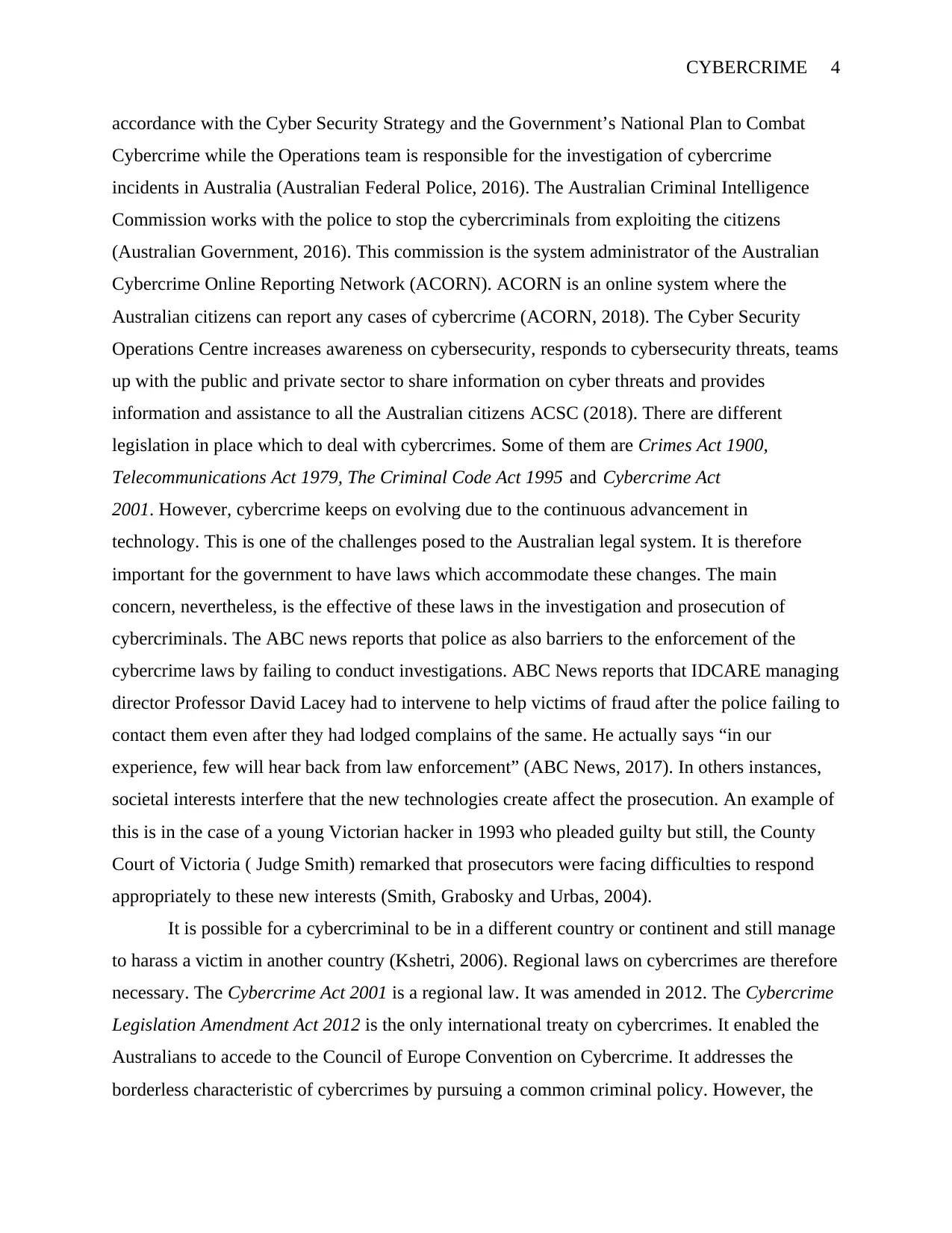
CYBERCRIME 4
accordance with the Cyber Security Strategy and the Government’s National Plan to Combat
Cybercrime while the Operations team is responsible for the investigation of cybercrime
incidents in Australia (Australian Federal Police, 2016). The Australian Criminal Intelligence
Commission works with the police to stop the cybercriminals from exploiting the citizens
(Australian Government, 2016). This commission is the system administrator of the Australian
Cybercrime Online Reporting Network (ACORN). ACORN is an online system where the
Australian citizens can report any cases of cybercrime (ACORN, 2018). The Cyber Security
Operations Centre increases awareness on cybersecurity, responds to cybersecurity threats, teams
up with the public and private sector to share information on cyber threats and provides
information and assistance to all the Australian citizens ACSC (2018). There are different
legislation in place which to deal with cybercrimes. Some of them are Crimes Act 1900,
Telecommunications Act 1979, The Criminal Code Act 1995 and Cybercrime Act
2001. However, cybercrime keeps on evolving due to the continuous advancement in
technology. This is one of the challenges posed to the Australian legal system. It is therefore
important for the government to have laws which accommodate these changes. The main
concern, nevertheless, is the effective of these laws in the investigation and prosecution of
cybercriminals. The ABC news reports that police as also barriers to the enforcement of the
cybercrime laws by failing to conduct investigations. ABC News reports that IDCARE managing
director Professor David Lacey had to intervene to help victims of fraud after the police failing to
contact them even after they had lodged complains of the same. He actually says “in our
experience, few will hear back from law enforcement” (ABC News, 2017). In others instances,
societal interests interfere that the new technologies create affect the prosecution. An example of
this is in the case of a young Victorian hacker in 1993 who pleaded guilty but still, the County
Court of Victoria ( Judge Smith) remarked that prosecutors were facing difficulties to respond
appropriately to these new interests (Smith, Grabosky and Urbas, 2004).
It is possible for a cybercriminal to be in a different country or continent and still manage
to harass a victim in another country (Kshetri, 2006). Regional laws on cybercrimes are therefore
necessary. The Cybercrime Act 2001 is a regional law. It was amended in 2012. The Cybercrime
Legislation Amendment Act 2012 is the only international treaty on cybercrimes. It enabled the
Australians to accede to the Council of Europe Convention on Cybercrime. It addresses the
borderless characteristic of cybercrimes by pursuing a common criminal policy. However, the
accordance with the Cyber Security Strategy and the Government’s National Plan to Combat
Cybercrime while the Operations team is responsible for the investigation of cybercrime
incidents in Australia (Australian Federal Police, 2016). The Australian Criminal Intelligence
Commission works with the police to stop the cybercriminals from exploiting the citizens
(Australian Government, 2016). This commission is the system administrator of the Australian
Cybercrime Online Reporting Network (ACORN). ACORN is an online system where the
Australian citizens can report any cases of cybercrime (ACORN, 2018). The Cyber Security
Operations Centre increases awareness on cybersecurity, responds to cybersecurity threats, teams
up with the public and private sector to share information on cyber threats and provides
information and assistance to all the Australian citizens ACSC (2018). There are different
legislation in place which to deal with cybercrimes. Some of them are Crimes Act 1900,
Telecommunications Act 1979, The Criminal Code Act 1995 and Cybercrime Act
2001. However, cybercrime keeps on evolving due to the continuous advancement in
technology. This is one of the challenges posed to the Australian legal system. It is therefore
important for the government to have laws which accommodate these changes. The main
concern, nevertheless, is the effective of these laws in the investigation and prosecution of
cybercriminals. The ABC news reports that police as also barriers to the enforcement of the
cybercrime laws by failing to conduct investigations. ABC News reports that IDCARE managing
director Professor David Lacey had to intervene to help victims of fraud after the police failing to
contact them even after they had lodged complains of the same. He actually says “in our
experience, few will hear back from law enforcement” (ABC News, 2017). In others instances,
societal interests interfere that the new technologies create affect the prosecution. An example of
this is in the case of a young Victorian hacker in 1993 who pleaded guilty but still, the County
Court of Victoria ( Judge Smith) remarked that prosecutors were facing difficulties to respond
appropriately to these new interests (Smith, Grabosky and Urbas, 2004).
It is possible for a cybercriminal to be in a different country or continent and still manage
to harass a victim in another country (Kshetri, 2006). Regional laws on cybercrimes are therefore
necessary. The Cybercrime Act 2001 is a regional law. It was amended in 2012. The Cybercrime
Legislation Amendment Act 2012 is the only international treaty on cybercrimes. It enabled the
Australians to accede to the Council of Europe Convention on Cybercrime. It addresses the
borderless characteristic of cybercrimes by pursuing a common criminal policy. However, the
Secure Best Marks with AI Grader
Need help grading? Try our AI Grader for instant feedback on your assignments.

CYBERCRIME 5
effectiveness of this law is yet to be felt in Australia as different jurisdictions have different
interpretations of the meaning of cybercrime. Australia’s Cybercrime Act 2001 understands
cybercrime as crimes that affect the data and systems of computers. The U1AE Federal law No.
2 of 2006 on the other hand, comprehends cybercrimes in broad perspective to mean all crimes
or offences against systems and data of computers, offences like fraud, money laundering, threats
or forgery that are computer related, offences related to content like a pornographic film
involving a child, including other offences like those that violate religious values and beliefs or
those that portend to violate family ethics. Even the definition of cybercrime from the USA
Department of Justice is different from the Australian definition in that it incorporates offenses
that target computer networks referring to viruses, worms or Dos attacks NCJRS (2018). The UK
Association of Chief Police Officers (ACPO) (33) has its own e-crime definition that addresses
the use of networked computers, telephony or internet technology to commit or facilitate a
criminal action (House of Commons, Home Affairs Committee, 2014). These are just but a few
jurisdictions that indeed show that the meaning of cybercrime varies depending on one’s region.
For that reason, computer crimes are criminalized differently in different countries. One
computer crime action in a certain jurisdiction could not be treated as not illegal in another
jurisdiction.
Lavorgna (2015) mentions that cybercrimes are organized crimes. From research, it has
been seen that criminal groups carry out offenses which target computer network which include
hacking and are committed by means of computer systems or networks (Lavorgna 2015). A
challenge faced by law enforcers is the inability to control this crime. The internet has unique
features thus making the application of legal principles difficult. Lavorgna states that it is
necessary for the law enforcement to have ‘technologies whose legitimate use is minimally
constrained while their illegitimate use is prevented and discouraged’. Such kind of technologies
is difficult to find. Even when found, cybercriminals might still hack into the system. The only
way such technologies can work is if only the law enforcers alone know about it and do not share
any information regarding it. Gillespie (2015), in his book ‘Cybercrime key issues and debates’,
focuses on cybercrimes committed on or facilitated by the internet. The crimes discussed include
cyberstalking, cyber harassment, cyberbullying, online piracy, virtual fraud, online hate speech,
and hacktivism just to name a few. He mentions that international law acknowledges a country's
or state's right to control the cyber activities in their territories and argues that an international
effectiveness of this law is yet to be felt in Australia as different jurisdictions have different
interpretations of the meaning of cybercrime. Australia’s Cybercrime Act 2001 understands
cybercrime as crimes that affect the data and systems of computers. The U1AE Federal law No.
2 of 2006 on the other hand, comprehends cybercrimes in broad perspective to mean all crimes
or offences against systems and data of computers, offences like fraud, money laundering, threats
or forgery that are computer related, offences related to content like a pornographic film
involving a child, including other offences like those that violate religious values and beliefs or
those that portend to violate family ethics. Even the definition of cybercrime from the USA
Department of Justice is different from the Australian definition in that it incorporates offenses
that target computer networks referring to viruses, worms or Dos attacks NCJRS (2018). The UK
Association of Chief Police Officers (ACPO) (33) has its own e-crime definition that addresses
the use of networked computers, telephony or internet technology to commit or facilitate a
criminal action (House of Commons, Home Affairs Committee, 2014). These are just but a few
jurisdictions that indeed show that the meaning of cybercrime varies depending on one’s region.
For that reason, computer crimes are criminalized differently in different countries. One
computer crime action in a certain jurisdiction could not be treated as not illegal in another
jurisdiction.
Lavorgna (2015) mentions that cybercrimes are organized crimes. From research, it has
been seen that criminal groups carry out offenses which target computer network which include
hacking and are committed by means of computer systems or networks (Lavorgna 2015). A
challenge faced by law enforcers is the inability to control this crime. The internet has unique
features thus making the application of legal principles difficult. Lavorgna states that it is
necessary for the law enforcement to have ‘technologies whose legitimate use is minimally
constrained while their illegitimate use is prevented and discouraged’. Such kind of technologies
is difficult to find. Even when found, cybercriminals might still hack into the system. The only
way such technologies can work is if only the law enforcers alone know about it and do not share
any information regarding it. Gillespie (2015), in his book ‘Cybercrime key issues and debates’,
focuses on cybercrimes committed on or facilitated by the internet. The crimes discussed include
cyberstalking, cyber harassment, cyberbullying, online piracy, virtual fraud, online hate speech,
and hacktivism just to name a few. He mentions that international law acknowledges a country's
or state's right to control the cyber activities in their territories and argues that an international
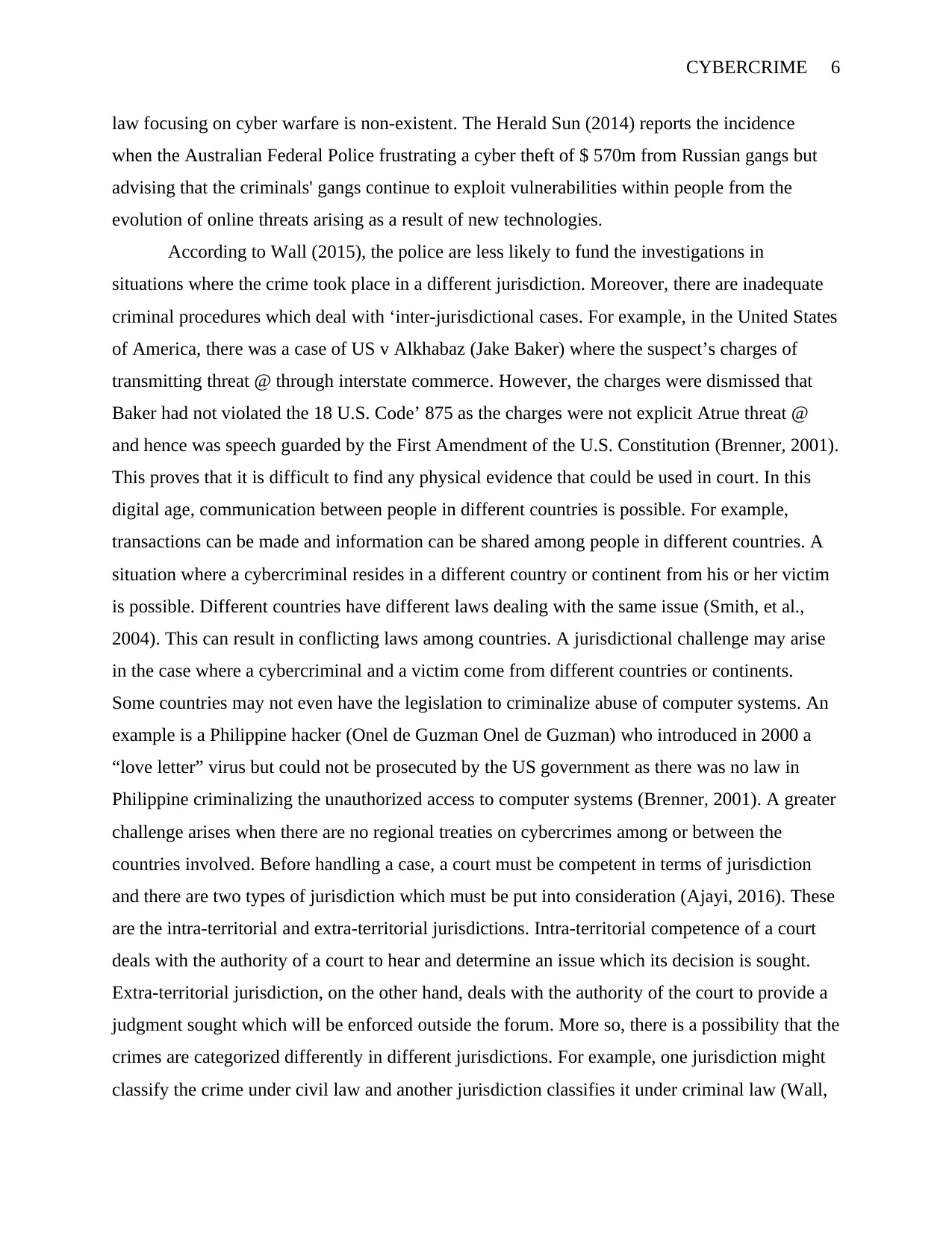
CYBERCRIME 6
law focusing on cyber warfare is non-existent. The Herald Sun (2014) reports the incidence
when the Australian Federal Police frustrating a cyber theft of $ 570m from Russian gangs but
advising that the criminals' gangs continue to exploit vulnerabilities within people from the
evolution of online threats arising as a result of new technologies.
According to Wall (2015), the police are less likely to fund the investigations in
situations where the crime took place in a different jurisdiction. Moreover, there are inadequate
criminal procedures which deal with ‘inter-jurisdictional cases. For example, in the United States
of America, there was a case of US v Alkhabaz (Jake Baker) where the suspect’s charges of
transmitting threat @ through interstate commerce. However, the charges were dismissed that
Baker had not violated the 18 U.S. Code’ 875 as the charges were not explicit Atrue threat @
and hence was speech guarded by the First Amendment of the U.S. Constitution (Brenner, 2001).
This proves that it is difficult to find any physical evidence that could be used in court. In this
digital age, communication between people in different countries is possible. For example,
transactions can be made and information can be shared among people in different countries. A
situation where a cybercriminal resides in a different country or continent from his or her victim
is possible. Different countries have different laws dealing with the same issue (Smith, et al.,
2004). This can result in conflicting laws among countries. A jurisdictional challenge may arise
in the case where a cybercriminal and a victim come from different countries or continents.
Some countries may not even have the legislation to criminalize abuse of computer systems. An
example is a Philippine hacker (Onel de Guzman Onel de Guzman) who introduced in 2000 a
“love letter” virus but could not be prosecuted by the US government as there was no law in
Philippine criminalizing the unauthorized access to computer systems (Brenner, 2001). A greater
challenge arises when there are no regional treaties on cybercrimes among or between the
countries involved. Before handling a case, a court must be competent in terms of jurisdiction
and there are two types of jurisdiction which must be put into consideration (Ajayi, 2016). These
are the intra-territorial and extra-territorial jurisdictions. Intra-territorial competence of a court
deals with the authority of a court to hear and determine an issue which its decision is sought.
Extra-territorial jurisdiction, on the other hand, deals with the authority of the court to provide a
judgment sought which will be enforced outside the forum. More so, there is a possibility that the
crimes are categorized differently in different jurisdictions. For example, one jurisdiction might
classify the crime under civil law and another jurisdiction classifies it under criminal law (Wall,
law focusing on cyber warfare is non-existent. The Herald Sun (2014) reports the incidence
when the Australian Federal Police frustrating a cyber theft of $ 570m from Russian gangs but
advising that the criminals' gangs continue to exploit vulnerabilities within people from the
evolution of online threats arising as a result of new technologies.
According to Wall (2015), the police are less likely to fund the investigations in
situations where the crime took place in a different jurisdiction. Moreover, there are inadequate
criminal procedures which deal with ‘inter-jurisdictional cases. For example, in the United States
of America, there was a case of US v Alkhabaz (Jake Baker) where the suspect’s charges of
transmitting threat @ through interstate commerce. However, the charges were dismissed that
Baker had not violated the 18 U.S. Code’ 875 as the charges were not explicit Atrue threat @
and hence was speech guarded by the First Amendment of the U.S. Constitution (Brenner, 2001).
This proves that it is difficult to find any physical evidence that could be used in court. In this
digital age, communication between people in different countries is possible. For example,
transactions can be made and information can be shared among people in different countries. A
situation where a cybercriminal resides in a different country or continent from his or her victim
is possible. Different countries have different laws dealing with the same issue (Smith, et al.,
2004). This can result in conflicting laws among countries. A jurisdictional challenge may arise
in the case where a cybercriminal and a victim come from different countries or continents.
Some countries may not even have the legislation to criminalize abuse of computer systems. An
example is a Philippine hacker (Onel de Guzman Onel de Guzman) who introduced in 2000 a
“love letter” virus but could not be prosecuted by the US government as there was no law in
Philippine criminalizing the unauthorized access to computer systems (Brenner, 2001). A greater
challenge arises when there are no regional treaties on cybercrimes among or between the
countries involved. Before handling a case, a court must be competent in terms of jurisdiction
and there are two types of jurisdiction which must be put into consideration (Ajayi, 2016). These
are the intra-territorial and extra-territorial jurisdictions. Intra-territorial competence of a court
deals with the authority of a court to hear and determine an issue which its decision is sought.
Extra-territorial jurisdiction, on the other hand, deals with the authority of the court to provide a
judgment sought which will be enforced outside the forum. More so, there is a possibility that the
crimes are categorized differently in different jurisdictions. For example, one jurisdiction might
classify the crime under civil law and another jurisdiction classifies it under criminal law (Wall,
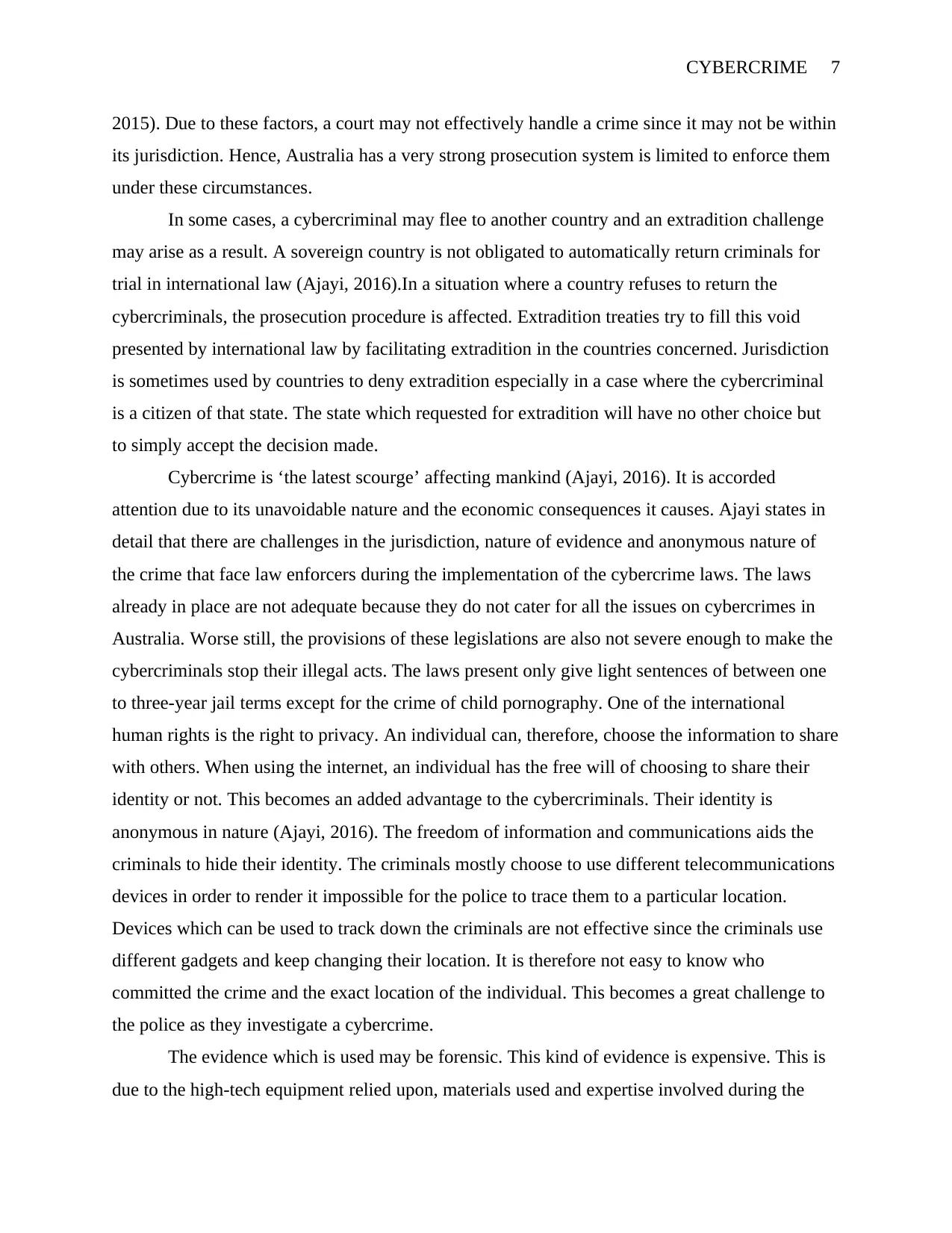
CYBERCRIME 7
2015). Due to these factors, a court may not effectively handle a crime since it may not be within
its jurisdiction. Hence, Australia has a very strong prosecution system is limited to enforce them
under these circumstances.
In some cases, a cybercriminal may flee to another country and an extradition challenge
may arise as a result. A sovereign country is not obligated to automatically return criminals for
trial in international law (Ajayi, 2016).In a situation where a country refuses to return the
cybercriminals, the prosecution procedure is affected. Extradition treaties try to fill this void
presented by international law by facilitating extradition in the countries concerned. Jurisdiction
is sometimes used by countries to deny extradition especially in a case where the cybercriminal
is a citizen of that state. The state which requested for extradition will have no other choice but
to simply accept the decision made.
Cybercrime is ‘the latest scourge’ affecting mankind (Ajayi, 2016). It is accorded
attention due to its unavoidable nature and the economic consequences it causes. Ajayi states in
detail that there are challenges in the jurisdiction, nature of evidence and anonymous nature of
the crime that face law enforcers during the implementation of the cybercrime laws. The laws
already in place are not adequate because they do not cater for all the issues on cybercrimes in
Australia. Worse still, the provisions of these legislations are also not severe enough to make the
cybercriminals stop their illegal acts. The laws present only give light sentences of between one
to three-year jail terms except for the crime of child pornography. One of the international
human rights is the right to privacy. An individual can, therefore, choose the information to share
with others. When using the internet, an individual has the free will of choosing to share their
identity or not. This becomes an added advantage to the cybercriminals. Their identity is
anonymous in nature (Ajayi, 2016). The freedom of information and communications aids the
criminals to hide their identity. The criminals mostly choose to use different telecommunications
devices in order to render it impossible for the police to trace them to a particular location.
Devices which can be used to track down the criminals are not effective since the criminals use
different gadgets and keep changing their location. It is therefore not easy to know who
committed the crime and the exact location of the individual. This becomes a great challenge to
the police as they investigate a cybercrime.
The evidence which is used may be forensic. This kind of evidence is expensive. This is
due to the high-tech equipment relied upon, materials used and expertise involved during the
2015). Due to these factors, a court may not effectively handle a crime since it may not be within
its jurisdiction. Hence, Australia has a very strong prosecution system is limited to enforce them
under these circumstances.
In some cases, a cybercriminal may flee to another country and an extradition challenge
may arise as a result. A sovereign country is not obligated to automatically return criminals for
trial in international law (Ajayi, 2016).In a situation where a country refuses to return the
cybercriminals, the prosecution procedure is affected. Extradition treaties try to fill this void
presented by international law by facilitating extradition in the countries concerned. Jurisdiction
is sometimes used by countries to deny extradition especially in a case where the cybercriminal
is a citizen of that state. The state which requested for extradition will have no other choice but
to simply accept the decision made.
Cybercrime is ‘the latest scourge’ affecting mankind (Ajayi, 2016). It is accorded
attention due to its unavoidable nature and the economic consequences it causes. Ajayi states in
detail that there are challenges in the jurisdiction, nature of evidence and anonymous nature of
the crime that face law enforcers during the implementation of the cybercrime laws. The laws
already in place are not adequate because they do not cater for all the issues on cybercrimes in
Australia. Worse still, the provisions of these legislations are also not severe enough to make the
cybercriminals stop their illegal acts. The laws present only give light sentences of between one
to three-year jail terms except for the crime of child pornography. One of the international
human rights is the right to privacy. An individual can, therefore, choose the information to share
with others. When using the internet, an individual has the free will of choosing to share their
identity or not. This becomes an added advantage to the cybercriminals. Their identity is
anonymous in nature (Ajayi, 2016). The freedom of information and communications aids the
criminals to hide their identity. The criminals mostly choose to use different telecommunications
devices in order to render it impossible for the police to trace them to a particular location.
Devices which can be used to track down the criminals are not effective since the criminals use
different gadgets and keep changing their location. It is therefore not easy to know who
committed the crime and the exact location of the individual. This becomes a great challenge to
the police as they investigate a cybercrime.
The evidence which is used may be forensic. This kind of evidence is expensive. This is
due to the high-tech equipment relied upon, materials used and expertise involved during the
Paraphrase This Document
Need a fresh take? Get an instant paraphrase of this document with our AI Paraphraser
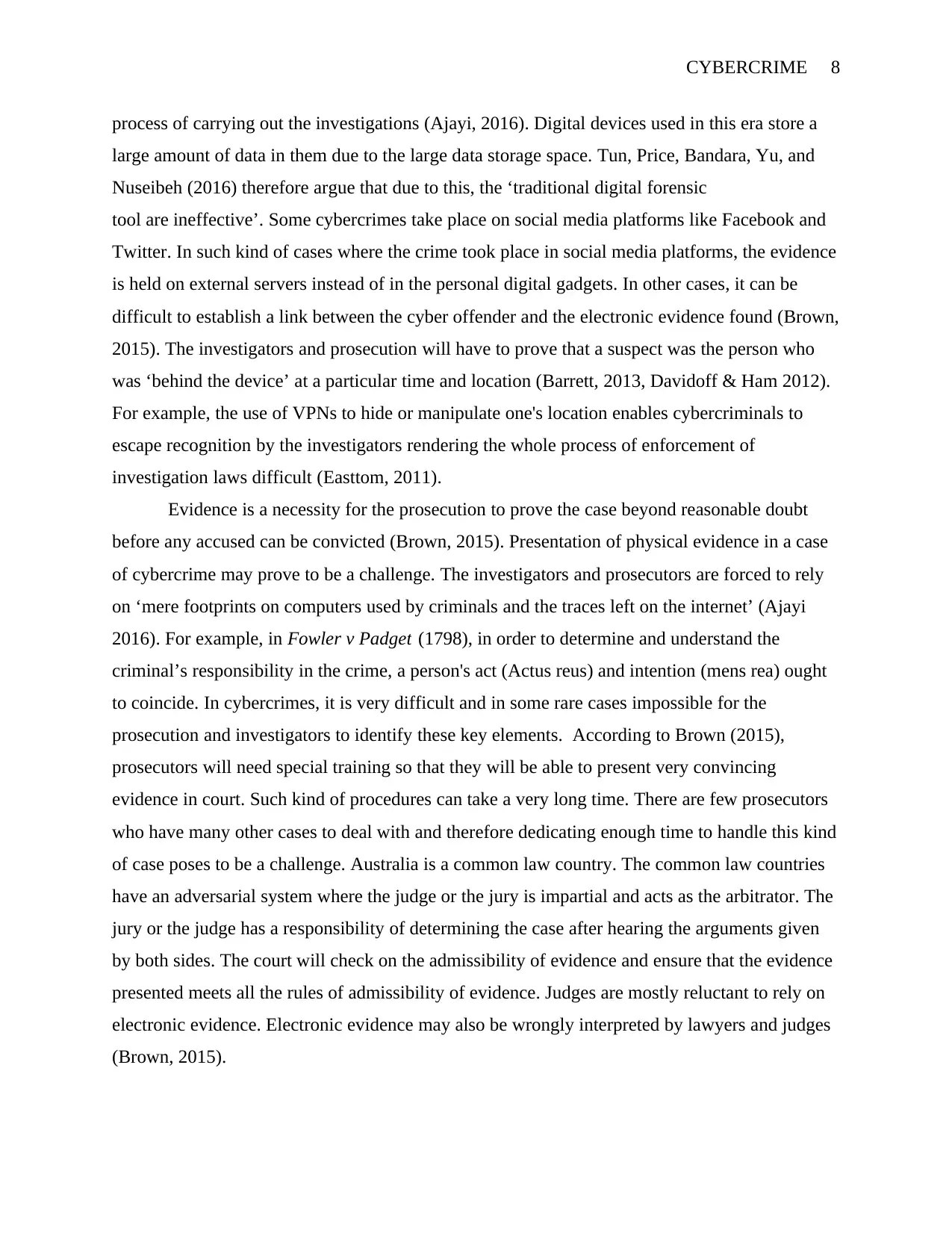
CYBERCRIME 8
process of carrying out the investigations (Ajayi, 2016). Digital devices used in this era store a
large amount of data in them due to the large data storage space. Tun, Price, Bandara, Yu, and
Nuseibeh (2016) therefore argue that due to this, the ‘traditional digital forensic
tool are ineffective’. Some cybercrimes take place on social media platforms like Facebook and
Twitter. In such kind of cases where the crime took place in social media platforms, the evidence
is held on external servers instead of in the personal digital gadgets. In other cases, it can be
difficult to establish a link between the cyber offender and the electronic evidence found (Brown,
2015). The investigators and prosecution will have to prove that a suspect was the person who
was ‘behind the device’ at a particular time and location (Barrett, 2013, Davidoff & Ham 2012).
For example, the use of VPNs to hide or manipulate one's location enables cybercriminals to
escape recognition by the investigators rendering the whole process of enforcement of
investigation laws difficult (Easttom, 2011).
Evidence is a necessity for the prosecution to prove the case beyond reasonable doubt
before any accused can be convicted (Brown, 2015). Presentation of physical evidence in a case
of cybercrime may prove to be a challenge. The investigators and prosecutors are forced to rely
on ‘mere footprints on computers used by criminals and the traces left on the internet’ (Ajayi
2016). For example, in Fowler v Padget (1798), in order to determine and understand the
criminal’s responsibility in the crime, a person's act (Actus reus) and intention (mens rea) ought
to coincide. In cybercrimes, it is very difficult and in some rare cases impossible for the
prosecution and investigators to identify these key elements. According to Brown (2015),
prosecutors will need special training so that they will be able to present very convincing
evidence in court. Such kind of procedures can take a very long time. There are few prosecutors
who have many other cases to deal with and therefore dedicating enough time to handle this kind
of case poses to be a challenge. Australia is a common law country. The common law countries
have an adversarial system where the judge or the jury is impartial and acts as the arbitrator. The
jury or the judge has a responsibility of determining the case after hearing the arguments given
by both sides. The court will check on the admissibility of evidence and ensure that the evidence
presented meets all the rules of admissibility of evidence. Judges are mostly reluctant to rely on
electronic evidence. Electronic evidence may also be wrongly interpreted by lawyers and judges
(Brown, 2015).
process of carrying out the investigations (Ajayi, 2016). Digital devices used in this era store a
large amount of data in them due to the large data storage space. Tun, Price, Bandara, Yu, and
Nuseibeh (2016) therefore argue that due to this, the ‘traditional digital forensic
tool are ineffective’. Some cybercrimes take place on social media platforms like Facebook and
Twitter. In such kind of cases where the crime took place in social media platforms, the evidence
is held on external servers instead of in the personal digital gadgets. In other cases, it can be
difficult to establish a link between the cyber offender and the electronic evidence found (Brown,
2015). The investigators and prosecution will have to prove that a suspect was the person who
was ‘behind the device’ at a particular time and location (Barrett, 2013, Davidoff & Ham 2012).
For example, the use of VPNs to hide or manipulate one's location enables cybercriminals to
escape recognition by the investigators rendering the whole process of enforcement of
investigation laws difficult (Easttom, 2011).
Evidence is a necessity for the prosecution to prove the case beyond reasonable doubt
before any accused can be convicted (Brown, 2015). Presentation of physical evidence in a case
of cybercrime may prove to be a challenge. The investigators and prosecutors are forced to rely
on ‘mere footprints on computers used by criminals and the traces left on the internet’ (Ajayi
2016). For example, in Fowler v Padget (1798), in order to determine and understand the
criminal’s responsibility in the crime, a person's act (Actus reus) and intention (mens rea) ought
to coincide. In cybercrimes, it is very difficult and in some rare cases impossible for the
prosecution and investigators to identify these key elements. According to Brown (2015),
prosecutors will need special training so that they will be able to present very convincing
evidence in court. Such kind of procedures can take a very long time. There are few prosecutors
who have many other cases to deal with and therefore dedicating enough time to handle this kind
of case poses to be a challenge. Australia is a common law country. The common law countries
have an adversarial system where the judge or the jury is impartial and acts as the arbitrator. The
jury or the judge has a responsibility of determining the case after hearing the arguments given
by both sides. The court will check on the admissibility of evidence and ensure that the evidence
presented meets all the rules of admissibility of evidence. Judges are mostly reluctant to rely on
electronic evidence. Electronic evidence may also be wrongly interpreted by lawyers and judges
(Brown, 2015).
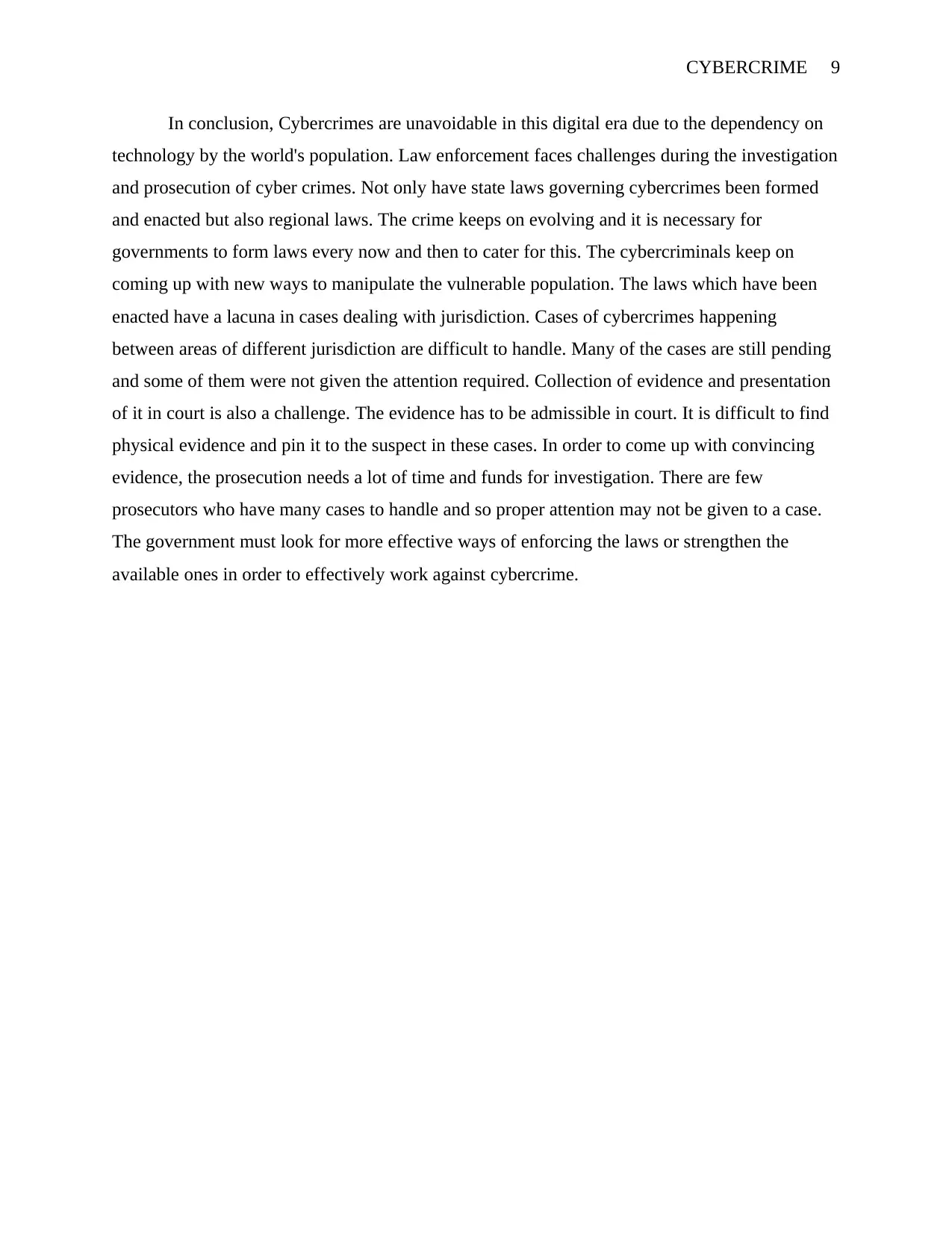
CYBERCRIME 9
In conclusion, Cybercrimes are unavoidable in this digital era due to the dependency on
technology by the world's population. Law enforcement faces challenges during the investigation
and prosecution of cyber crimes. Not only have state laws governing cybercrimes been formed
and enacted but also regional laws. The crime keeps on evolving and it is necessary for
governments to form laws every now and then to cater for this. The cybercriminals keep on
coming up with new ways to manipulate the vulnerable population. The laws which have been
enacted have a lacuna in cases dealing with jurisdiction. Cases of cybercrimes happening
between areas of different jurisdiction are difficult to handle. Many of the cases are still pending
and some of them were not given the attention required. Collection of evidence and presentation
of it in court is also a challenge. The evidence has to be admissible in court. It is difficult to find
physical evidence and pin it to the suspect in these cases. In order to come up with convincing
evidence, the prosecution needs a lot of time and funds for investigation. There are few
prosecutors who have many cases to handle and so proper attention may not be given to a case.
The government must look for more effective ways of enforcing the laws or strengthen the
available ones in order to effectively work against cybercrime.
In conclusion, Cybercrimes are unavoidable in this digital era due to the dependency on
technology by the world's population. Law enforcement faces challenges during the investigation
and prosecution of cyber crimes. Not only have state laws governing cybercrimes been formed
and enacted but also regional laws. The crime keeps on evolving and it is necessary for
governments to form laws every now and then to cater for this. The cybercriminals keep on
coming up with new ways to manipulate the vulnerable population. The laws which have been
enacted have a lacuna in cases dealing with jurisdiction. Cases of cybercrimes happening
between areas of different jurisdiction are difficult to handle. Many of the cases are still pending
and some of them were not given the attention required. Collection of evidence and presentation
of it in court is also a challenge. The evidence has to be admissible in court. It is difficult to find
physical evidence and pin it to the suspect in these cases. In order to come up with convincing
evidence, the prosecution needs a lot of time and funds for investigation. There are few
prosecutors who have many cases to handle and so proper attention may not be given to a case.
The government must look for more effective ways of enforcing the laws or strengthen the
available ones in order to effectively work against cybercrime.
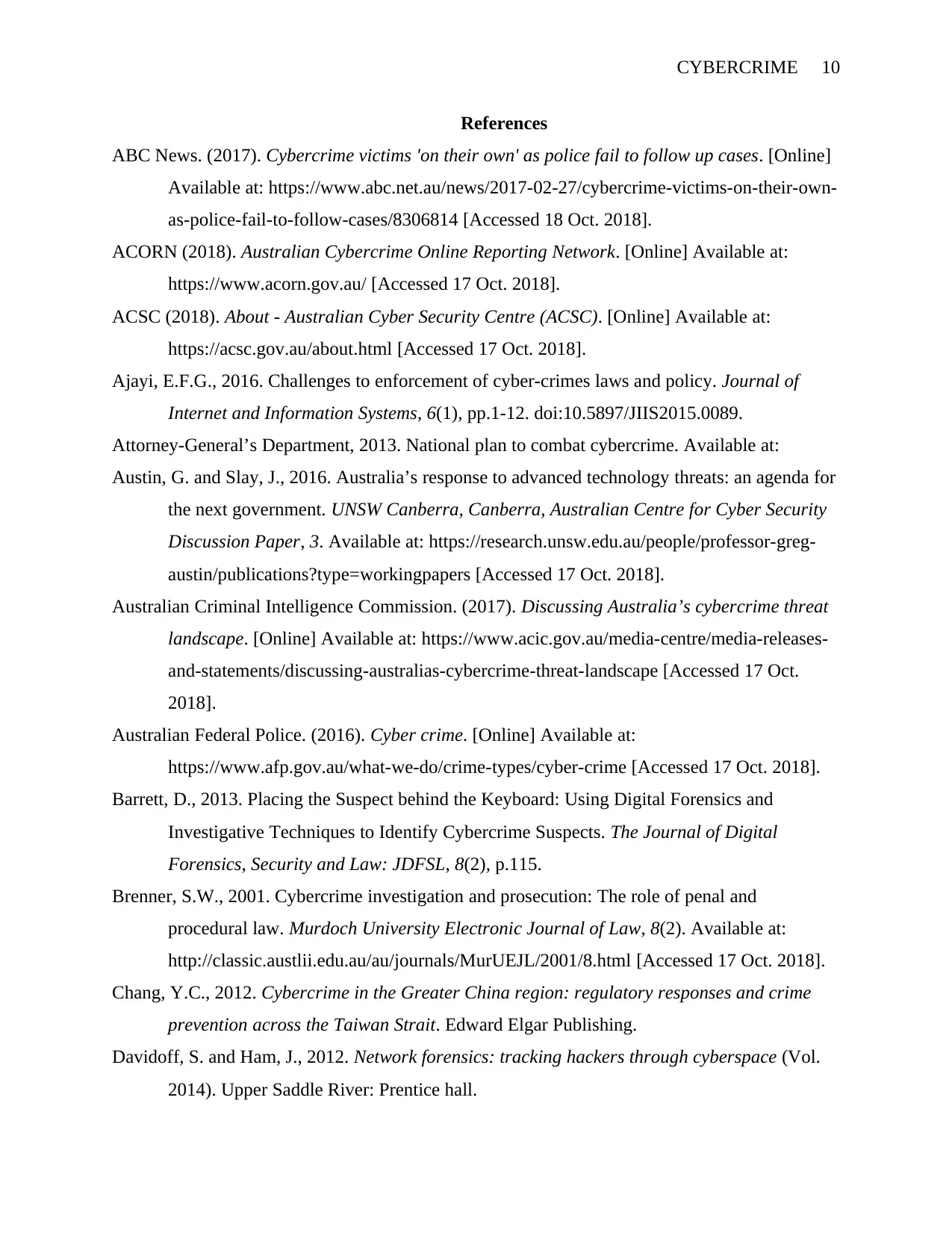
CYBERCRIME 10
References
ABC News. (2017). Cybercrime victims 'on their own' as police fail to follow up cases. [Online]
Available at: https://www.abc.net.au/news/2017-02-27/cybercrime-victims-on-their-own-
as-police-fail-to-follow-cases/8306814 [Accessed 18 Oct. 2018].
ACORN (2018). Australian Cybercrime Online Reporting Network. [Online] Available at:
https://www.acorn.gov.au/ [Accessed 17 Oct. 2018].
ACSC (2018). About - Australian Cyber Security Centre (ACSC). [Online] Available at:
https://acsc.gov.au/about.html [Accessed 17 Oct. 2018].
Ajayi, E.F.G., 2016. Challenges to enforcement of cyber-crimes laws and policy. Journal of
Internet and Information Systems, 6(1), pp.1-12. doi:10.5897/JIIS2015.0089.
Attorney-General’s Department, 2013. National plan to combat cybercrime. Available at:
Austin, G. and Slay, J., 2016. Australia’s response to advanced technology threats: an agenda for
the next government. UNSW Canberra, Canberra, Australian Centre for Cyber Security
Discussion Paper, 3. Available at: https://research.unsw.edu.au/people/professor-greg-
austin/publications?type=workingpapers [Accessed 17 Oct. 2018].
Australian Criminal Intelligence Commission. (2017). Discussing Australia’s cybercrime threat
landscape. [Online] Available at: https://www.acic.gov.au/media-centre/media-releases-
and-statements/discussing-australias-cybercrime-threat-landscape [Accessed 17 Oct.
2018].
Australian Federal Police. (2016). Cyber crime. [Online] Available at:
https://www.afp.gov.au/what-we-do/crime-types/cyber-crime [Accessed 17 Oct. 2018].
Barrett, D., 2013. Placing the Suspect behind the Keyboard: Using Digital Forensics and
Investigative Techniques to Identify Cybercrime Suspects. The Journal of Digital
Forensics, Security and Law: JDFSL, 8(2), p.115.
Brenner, S.W., 2001. Cybercrime investigation and prosecution: The role of penal and
procedural law. Murdoch University Electronic Journal of Law, 8(2). Available at:
http://classic.austlii.edu.au/au/journals/MurUEJL/2001/8.html [Accessed 17 Oct. 2018].
Chang, Y.C., 2012. Cybercrime in the Greater China region: regulatory responses and crime
prevention across the Taiwan Strait. Edward Elgar Publishing.
Davidoff, S. and Ham, J., 2012. Network forensics: tracking hackers through cyberspace (Vol.
2014). Upper Saddle River: Prentice hall.
References
ABC News. (2017). Cybercrime victims 'on their own' as police fail to follow up cases. [Online]
Available at: https://www.abc.net.au/news/2017-02-27/cybercrime-victims-on-their-own-
as-police-fail-to-follow-cases/8306814 [Accessed 18 Oct. 2018].
ACORN (2018). Australian Cybercrime Online Reporting Network. [Online] Available at:
https://www.acorn.gov.au/ [Accessed 17 Oct. 2018].
ACSC (2018). About - Australian Cyber Security Centre (ACSC). [Online] Available at:
https://acsc.gov.au/about.html [Accessed 17 Oct. 2018].
Ajayi, E.F.G., 2016. Challenges to enforcement of cyber-crimes laws and policy. Journal of
Internet and Information Systems, 6(1), pp.1-12. doi:10.5897/JIIS2015.0089.
Attorney-General’s Department, 2013. National plan to combat cybercrime. Available at:
Austin, G. and Slay, J., 2016. Australia’s response to advanced technology threats: an agenda for
the next government. UNSW Canberra, Canberra, Australian Centre for Cyber Security
Discussion Paper, 3. Available at: https://research.unsw.edu.au/people/professor-greg-
austin/publications?type=workingpapers [Accessed 17 Oct. 2018].
Australian Criminal Intelligence Commission. (2017). Discussing Australia’s cybercrime threat
landscape. [Online] Available at: https://www.acic.gov.au/media-centre/media-releases-
and-statements/discussing-australias-cybercrime-threat-landscape [Accessed 17 Oct.
2018].
Australian Federal Police. (2016). Cyber crime. [Online] Available at:
https://www.afp.gov.au/what-we-do/crime-types/cyber-crime [Accessed 17 Oct. 2018].
Barrett, D., 2013. Placing the Suspect behind the Keyboard: Using Digital Forensics and
Investigative Techniques to Identify Cybercrime Suspects. The Journal of Digital
Forensics, Security and Law: JDFSL, 8(2), p.115.
Brenner, S.W., 2001. Cybercrime investigation and prosecution: The role of penal and
procedural law. Murdoch University Electronic Journal of Law, 8(2). Available at:
http://classic.austlii.edu.au/au/journals/MurUEJL/2001/8.html [Accessed 17 Oct. 2018].
Chang, Y.C., 2012. Cybercrime in the Greater China region: regulatory responses and crime
prevention across the Taiwan Strait. Edward Elgar Publishing.
Davidoff, S. and Ham, J., 2012. Network forensics: tracking hackers through cyberspace (Vol.
2014). Upper Saddle River: Prentice hall.
Secure Best Marks with AI Grader
Need help grading? Try our AI Grader for instant feedback on your assignments.
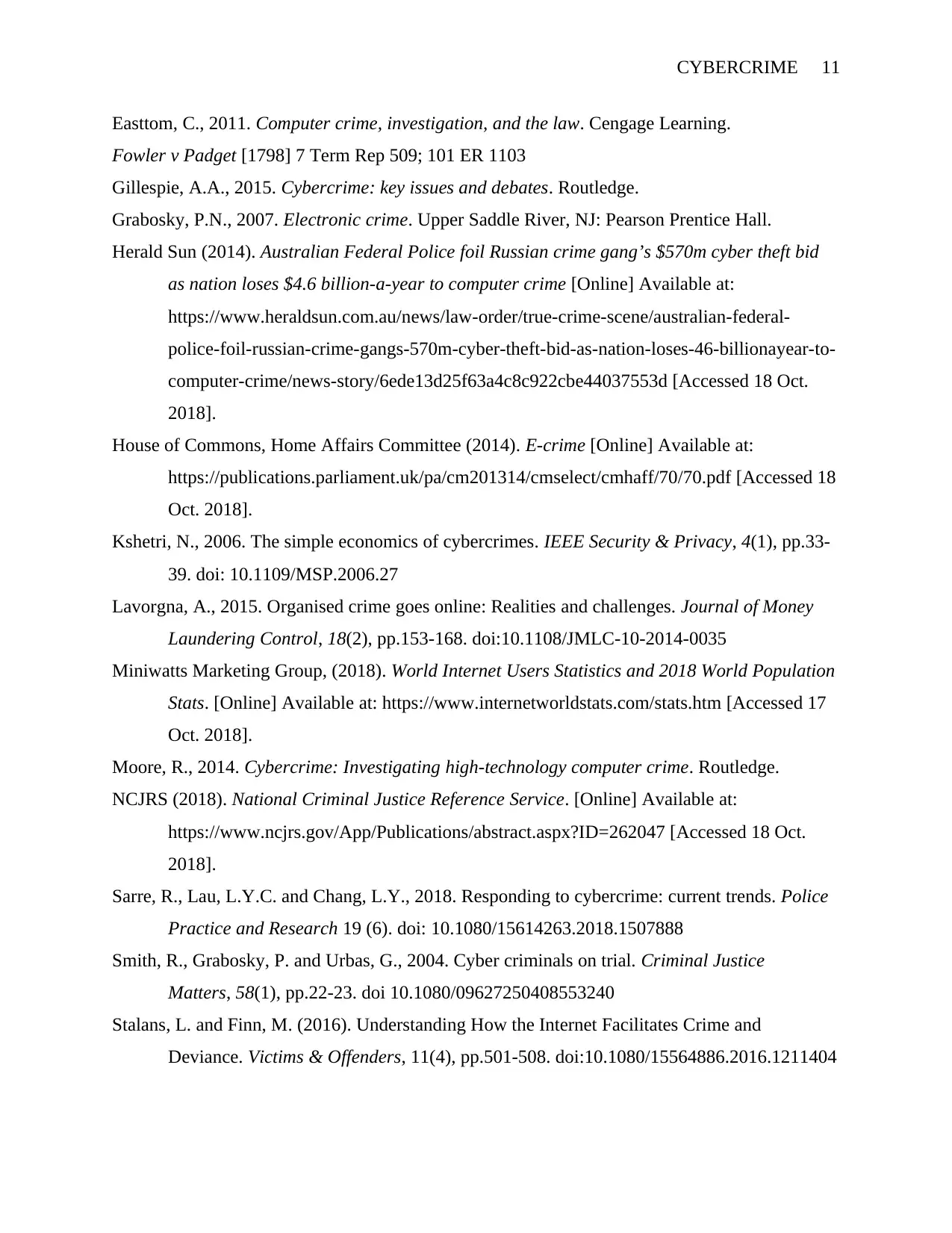
CYBERCRIME 11
Easttom, C., 2011. Computer crime, investigation, and the law. Cengage Learning.
Fowler v Padget [1798] 7 Term Rep 509; 101 ER 1103
Gillespie, A.A., 2015. Cybercrime: key issues and debates. Routledge.
Grabosky, P.N., 2007. Electronic crime. Upper Saddle River, NJ: Pearson Prentice Hall.
Herald Sun (2014). Australian Federal Police foil Russian crime gang’s $570m cyber theft bid
as nation loses $4.6 billion-a-year to computer crime [Online] Available at:
https://www.heraldsun.com.au/news/law-order/true-crime-scene/australian-federal-
police-foil-russian-crime-gangs-570m-cyber-theft-bid-as-nation-loses-46-billionayear-to-
computer-crime/news-story/6ede13d25f63a4c8c922cbe44037553d [Accessed 18 Oct.
2018].
House of Commons, Home Affairs Committee (2014). E-crime [Online] Available at:
https://publications.parliament.uk/pa/cm201314/cmselect/cmhaff/70/70.pdf [Accessed 18
Oct. 2018].
Kshetri, N., 2006. The simple economics of cybercrimes. IEEE Security & Privacy, 4(1), pp.33-
39. doi: 10.1109/MSP.2006.27
Lavorgna, A., 2015. Organised crime goes online: Realities and challenges. Journal of Money
Laundering Control, 18(2), pp.153-168. doi:10.1108/JMLC-10-2014-0035
Miniwatts Marketing Group, (2018). World Internet Users Statistics and 2018 World Population
Stats. [Online] Available at: https://www.internetworldstats.com/stats.htm [Accessed 17
Oct. 2018].
Moore, R., 2014. Cybercrime: Investigating high-technology computer crime. Routledge.
NCJRS (2018). National Criminal Justice Reference Service. [Online] Available at:
https://www.ncjrs.gov/App/Publications/abstract.aspx?ID=262047 [Accessed 18 Oct.
2018].
Sarre, R., Lau, L.Y.C. and Chang, L.Y., 2018. Responding to cybercrime: current trends. Police
Practice and Research 19 (6). doi: 10.1080/15614263.2018.1507888
Smith, R., Grabosky, P. and Urbas, G., 2004. Cyber criminals on trial. Criminal Justice
Matters, 58(1), pp.22-23. doi 10.1080/09627250408553240
Stalans, L. and Finn, M. (2016). Understanding How the Internet Facilitates Crime and
Deviance. Victims & Offenders, 11(4), pp.501-508. doi:10.1080/15564886.2016.1211404
Easttom, C., 2011. Computer crime, investigation, and the law. Cengage Learning.
Fowler v Padget [1798] 7 Term Rep 509; 101 ER 1103
Gillespie, A.A., 2015. Cybercrime: key issues and debates. Routledge.
Grabosky, P.N., 2007. Electronic crime. Upper Saddle River, NJ: Pearson Prentice Hall.
Herald Sun (2014). Australian Federal Police foil Russian crime gang’s $570m cyber theft bid
as nation loses $4.6 billion-a-year to computer crime [Online] Available at:
https://www.heraldsun.com.au/news/law-order/true-crime-scene/australian-federal-
police-foil-russian-crime-gangs-570m-cyber-theft-bid-as-nation-loses-46-billionayear-to-
computer-crime/news-story/6ede13d25f63a4c8c922cbe44037553d [Accessed 18 Oct.
2018].
House of Commons, Home Affairs Committee (2014). E-crime [Online] Available at:
https://publications.parliament.uk/pa/cm201314/cmselect/cmhaff/70/70.pdf [Accessed 18
Oct. 2018].
Kshetri, N., 2006. The simple economics of cybercrimes. IEEE Security & Privacy, 4(1), pp.33-
39. doi: 10.1109/MSP.2006.27
Lavorgna, A., 2015. Organised crime goes online: Realities and challenges. Journal of Money
Laundering Control, 18(2), pp.153-168. doi:10.1108/JMLC-10-2014-0035
Miniwatts Marketing Group, (2018). World Internet Users Statistics and 2018 World Population
Stats. [Online] Available at: https://www.internetworldstats.com/stats.htm [Accessed 17
Oct. 2018].
Moore, R., 2014. Cybercrime: Investigating high-technology computer crime. Routledge.
NCJRS (2018). National Criminal Justice Reference Service. [Online] Available at:
https://www.ncjrs.gov/App/Publications/abstract.aspx?ID=262047 [Accessed 18 Oct.
2018].
Sarre, R., Lau, L.Y.C. and Chang, L.Y., 2018. Responding to cybercrime: current trends. Police
Practice and Research 19 (6). doi: 10.1080/15614263.2018.1507888
Smith, R., Grabosky, P. and Urbas, G., 2004. Cyber criminals on trial. Criminal Justice
Matters, 58(1), pp.22-23. doi 10.1080/09627250408553240
Stalans, L. and Finn, M. (2016). Understanding How the Internet Facilitates Crime and
Deviance. Victims & Offenders, 11(4), pp.501-508. doi:10.1080/15564886.2016.1211404
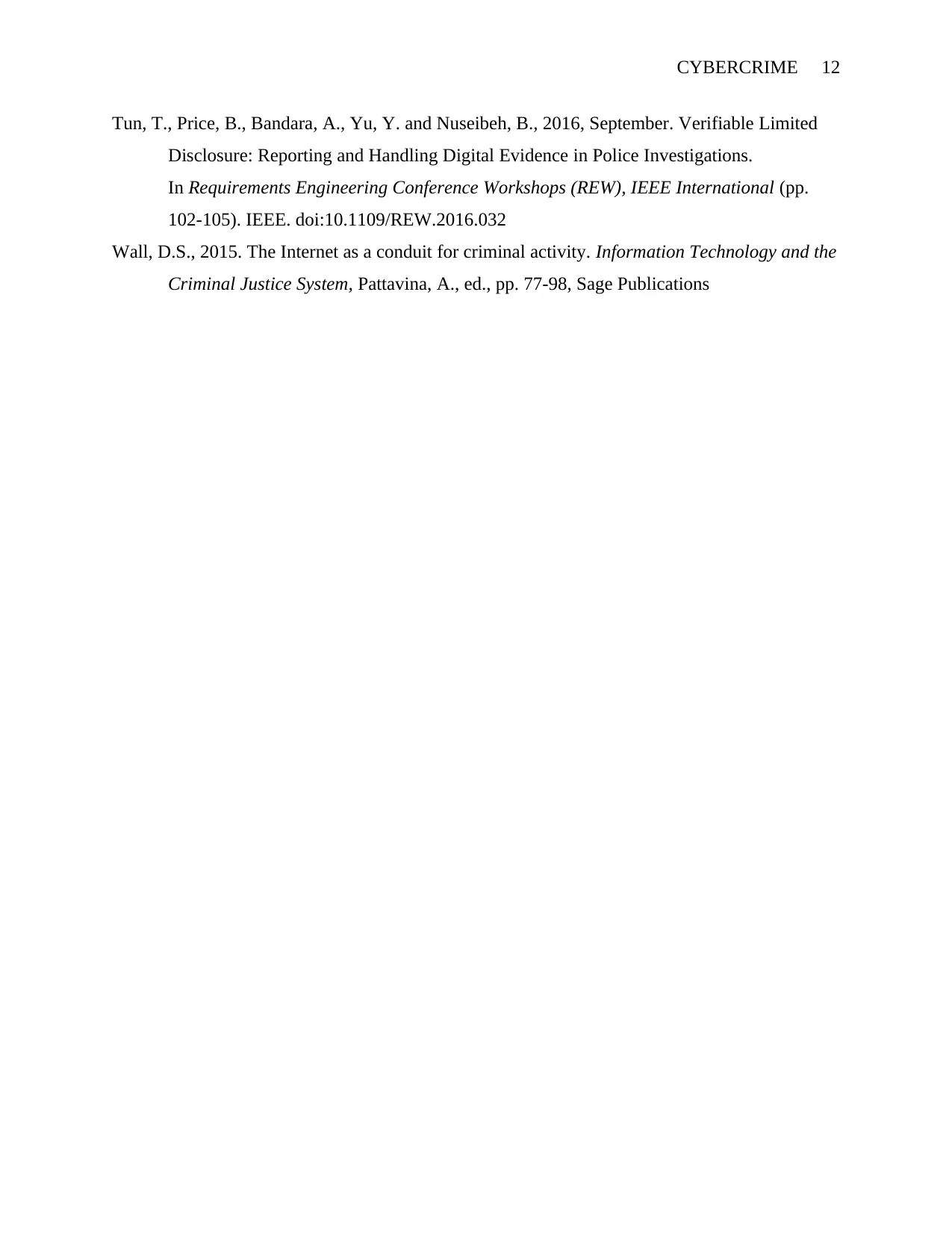
CYBERCRIME 12
Tun, T., Price, B., Bandara, A., Yu, Y. and Nuseibeh, B., 2016, September. Verifiable Limited
Disclosure: Reporting and Handling Digital Evidence in Police Investigations.
In Requirements Engineering Conference Workshops (REW), IEEE International (pp.
102-105). IEEE. doi:10.1109/REW.2016.032
Wall, D.S., 2015. The Internet as a conduit for criminal activity. Information Technology and the
Criminal Justice System, Pattavina, A., ed., pp. 77-98, Sage Publications
Tun, T., Price, B., Bandara, A., Yu, Y. and Nuseibeh, B., 2016, September. Verifiable Limited
Disclosure: Reporting and Handling Digital Evidence in Police Investigations.
In Requirements Engineering Conference Workshops (REW), IEEE International (pp.
102-105). IEEE. doi:10.1109/REW.2016.032
Wall, D.S., 2015. The Internet as a conduit for criminal activity. Information Technology and the
Criminal Justice System, Pattavina, A., ed., pp. 77-98, Sage Publications
1 out of 12
Related Documents
Your All-in-One AI-Powered Toolkit for Academic Success.
+13062052269
info@desklib.com
Available 24*7 on WhatsApp / Email
![[object Object]](/_next/static/media/star-bottom.7253800d.svg)
Unlock your academic potential
© 2024 | Zucol Services PVT LTD | All rights reserved.





